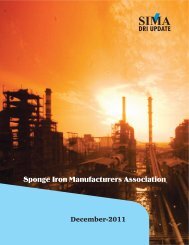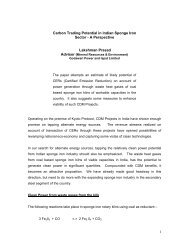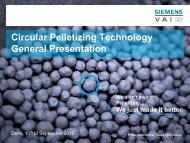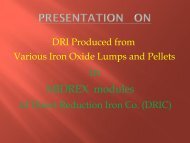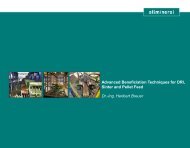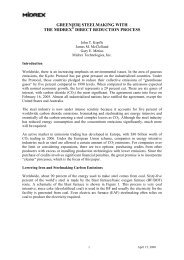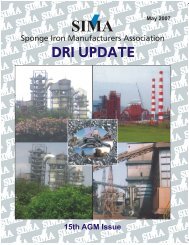sponge iron industry –past-present-future - SIMA
sponge iron industry –past-present-future - SIMA
sponge iron industry –past-present-future - SIMA
Create successful ePaper yourself
Turn your PDF publications into a flip-book with our unique Google optimized e-Paper software.
tubes. The newly reformed gas, containing 90-<br />
92 percent H2 and CO, is then fed hot directly<br />
to the shaft furnace as reducing gas.<br />
Heat Recovery<br />
The thermal efficiency of the MIDREX®<br />
Reformer is greatly enhanced by the heat<br />
recovery system. Sensible heat is recovered<br />
from the reformer flue gas to preheat the feed<br />
gas mixture, the burner combustion air and the<br />
natural gas feed. In addition, depending on the<br />
economics, the fuel gas may also be preheated<br />
Process Advantage<br />
l World Wide commercial use<br />
l Proven performance<br />
l Raw material flexibility<br />
l CO2 reformer eliminates need for steam system,<br />
reformed gas quench, reducing gas heating and<br />
CO2 removal system.<br />
HYL - Technology – Gas based Sponge <strong>iron</strong><br />
The HYL plants operate with <strong>iron</strong> ore, <strong>iron</strong> oxide<br />
pellets or mixture of the Two and natural gas.<br />
The main equipment of HYL-III comprises a<br />
DR shaft furnace, a gas reformer, and a gas<br />
reheater. The principles of operation of the<br />
furnace are similar to the midrex shaft furnace<br />
described previously.<br />
Continuously descending <strong>iron</strong>- bearing<br />
material is reduced in an upper zone by the<br />
counter current flow of gas, which is rich in<br />
carbon monoxide and hydrogen. Reduction is<br />
accomplished by reaction of the reducing gas<br />
which is introduced through a distribution<br />
system around the circumference of the shaft<br />
at an intermediate height.<br />
A proper selection of <strong>iron</strong> oxide feed stock<br />
permit operation at 950 °C. After reduction, the<br />
hot DRI continues to descend through a<br />
constant pressure zone, which separates the<br />
upper reducing zone from the lower cooling<br />
JANUARY-2011/16



